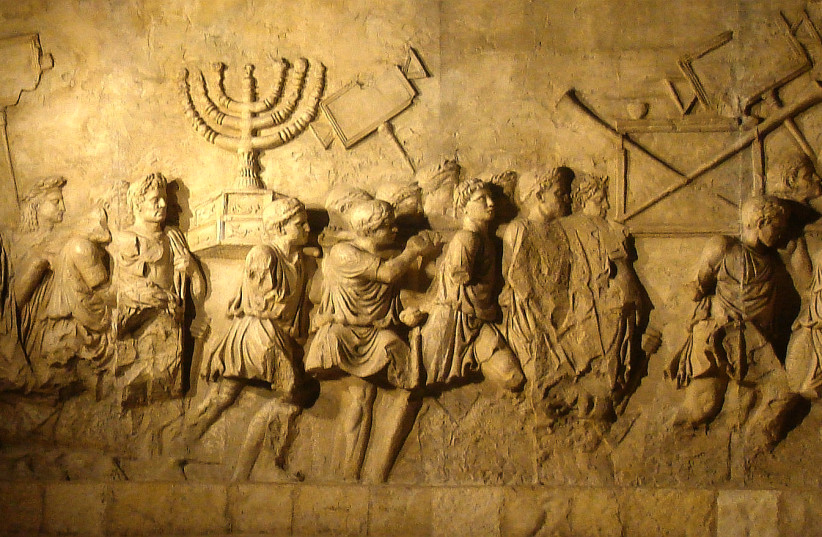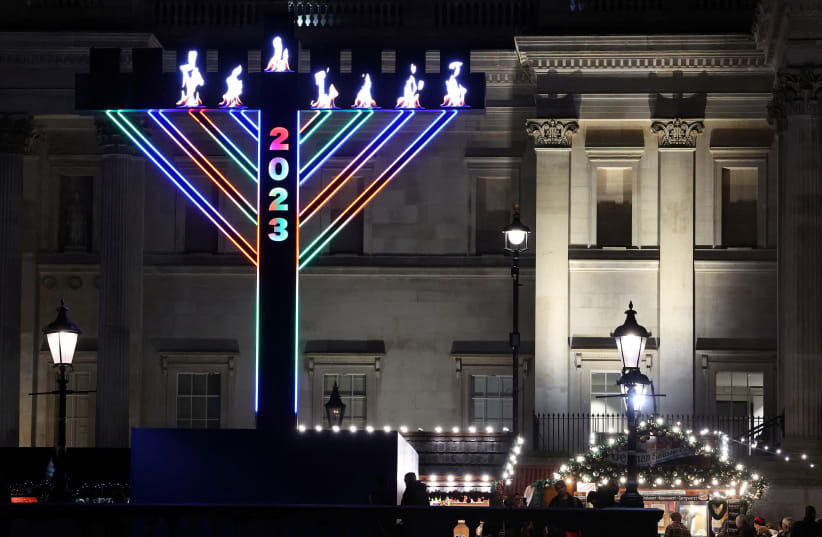This past Sunday night we hosted our annual hanukkiah (Hanukkah menorah) lighting at the Wellington arch, a stone’s throw away from His Majesty’s Buckingham Palace.
As I climbed the ladder to light the menorah, I took in a breathtaking 360-degree view of the heart of London, encircled by a bustling Park Lane, a dazzling Winter Wonderland, and the majestic outline of Buckingham palace.
As I looked up I saw the magnificent sculpture atop the arch, designed by Adrien Jones in 1891 entitled ‘Triumph.’
This is of particular significance as it recalls the Arch of Triumph in Paris which was inspired by the Arch of Titus in Rome.
If you’ve been to the Arch of Titus you will know that engraved on one side of the Arch is the tragic and humiliating scene depicting our ancestors forcibly taken into exile by Roman legions, carrying with them items from the Holy Temple, including a Menorah.


Indeed, immediately after the State of Israel was announced in 1948, the Jewish community of Rome symbolically gathered around the Arch of Titus to say the Jewish prayer of thanks, called Hallel, with profound appreciation to G-d for returning the Jewish exiles and their Menorah to Israel, their homeland.
How appropriate that the national emblem of the State of Israel includes a Menorah, symbolically marking the full cycle of Jewish history.
Which reminds me of a moving footnote in recent history.
In a now famous photo taken in 1931, a small brass menorah – all eight lights kindled – faces off against a menacing Nazi banner with a proud swastika.
It was the eighth night of Hanukkah in Kiel, Germany, a small town with a Jewish population of 500.
That year, 1931, the last night of Hanukkah fell on Friday evening, and Rabbi Akiva Boruch Posner, the spiritual leader of Kiel, was hurrying to light the Menorah before Shabbat set in.
Directly across the Posner’s home stood the imposing SS headquarters in town, displaying the dreaded Nazi Party flag in the cold December night.
With the eight lights of the menorah glowing brightly in her window, Rabbi Posner’s wife, Rachel, snapped a photo of the menorah and captured the Nazi headquarters and flag in the background.
She wrote these words in German on the back of the photo.
“Hanukkah, 1931.”
“Judah will die,” thus says the banner.
“Judah lives forever,” thus respond the lights.
Judah lives forever: How Israel and the Jews have preservered
Do you know where you can find the ancient Egyptian, Babylonian, Persian, and Roman empires, among all others who seek to destroy us in each generation?
In Museums, and on Wikipedia.
And do you know where you can find the descendants of Judah the Maccabee?
Illuminating the world through the Hanukkah lights, dedicated, as ever, to bringing hope and healing to our world.
One of the most symbolic candle lightings this year took place on the first night of Hanukkah at the Brandenburg Gate in Berlin, where the Chancellor of Germany kindled lights of love in the very place where his predecessor once stoked the flames of hate.
So as we conclude Hanukkah this year, at a time in history when things look bleak, and moral confusion and darkness seems to abound, let’s remember that the arc of history bends forward, and that, ultimately, love will always outlast hate, good will always triumph over evil, and light will always prevail over darkness.
Now more than ever, let us draw strength and inspiration from the Maccabees, past and present, and like them, let us become the living candles of hope, light, and love that our world needs more desperately than ever before.
Now more than ever, let us proudly proclaim, “Judah lives forever” – “Am Yisrael Chai”.
The writer is the rabbi of Beit Baruch and executive director of Chabad of Belgravia, London.
